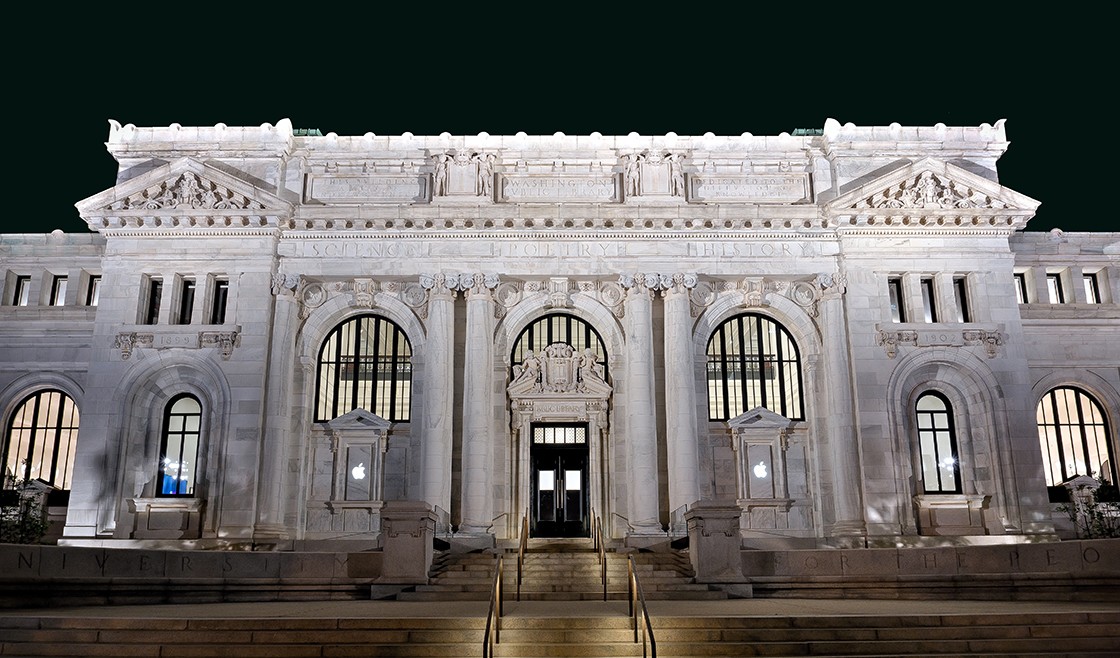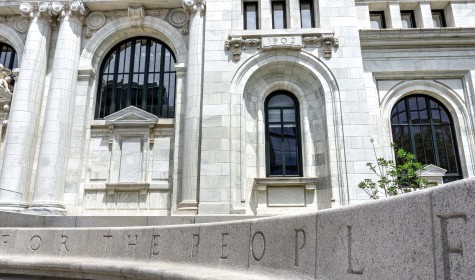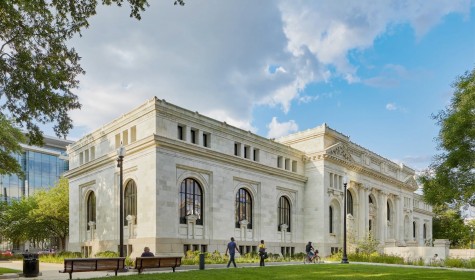Washington, D.C.’s Carnegie Library Continues Connecting People and Information as an Apple Store

retrofit magazine published the following article, which celebrates the restoration of Washington, D.C.'s first Carnegie Library, in their July/August 2021 issue. The article was contributed by BBB's Jennie Gwin.
This summer marks the second anniversary of the reopening of the restored and repurposed Carnegie Library at Mount Vernon Square in Washington, D.C. The restoration of this remarkable 118-year-old building has uplifted cultural and architectural history, facilitated the site’s renewed role in connecting individuals and information, and stimulated the local economy.
In 2016, after a nearly 50-year period of inconsistent use and maintenance, a promising new opportunity arose for the Carnegie Library. Events DC, the authority that manages the building on behalf of the district, along with many other cultural and recreational facilities, announced that it had entered into negotiations with Apple Inc. The proposal centered on the opening of a flagship store, the Fortune 500 retailer’s second retail location in the district with an aesthetic that embraced the building’s history and Beaux-Arts style.
History of the Building
Since 1903, Washington’s Carnegie Library building has anchored Mount Vernon Square, one of the original reservations in the George Washington-commissioned plan for the district by Pierre Charles L’Enfant. The building was the first Andrew Carnegie-funded library in Washington and is a significant example among the country’s thousands of Carnegie Libraries. It also has the distinction of being Washington’s first desegregated public building.
When approaching the Carnegie Library at Mount Vernon Square, visitors cannot miss these words: “A University for the People.” In keeping with its granite-carved promise, the building served as Washington’s Central Public Library for decades. In 1970, the district relocated the overcrowded central branch, and the site entered a prolonged period of underuse and disrepair. Before the newly restored building reopened in 2019, the Carnegie Library remained partially or wholly inaccessible to historians and citizen scholars. Among other corresponding impacts, public use of Mount Vernon Square’s adjacent green space declined.
The public’s relative lack of building access was not for want of trying. Most notably, in 1999, Congress granted a 99-year lease to the Historical Society of Washington, D.C., and provided funding in support of the City Museum, a new urban history museum. The Carnegie Library underwent significant changes during a related renovation, which included the replacement of a central skylight with infill slab and the construction of a new, higher-profile hipped roof. The City Museum closed in 2004, but parts of the building continued to serve as the base of operations for the Historical Society, which has since rebranded as the DC History Center.
Details of the Restoration
While the proposal for the library building to become an Apple Store had immense potential, there were notable challenges to overcome. The project required review and approval by the National Capital Planning Commission, Commission of Fine Arts and Washington’s Historic Preservation Review Board, as well as the District Department of Transportation, Department of Energy and Environment, and Department of Buildings.
In addition to improvements required to the interior, the exterior of the building was in need of a full restoration, accessibility upgrades and new district-required onsite stormwater management. Furthermore, the construction would temporarily displace, and then relocate, the DC History Center. Three years later, Apple Carnegie Library opened to the public. Because of Apple’s interest and subsequent stewardship of the historic site, the Carnegie Library has received its most extensive historic restoration to date, much needed accessibly improvements were made to the exterior, and Mount Vernon Square is once again a destination park in Washington.
To bring this project to fruition, a project team led by Beyer Blinder Belle Architects & Planners conducted a meticulous restoration of the Carnegie Library’s exterior and interior. The project team’s top priorities were the careful preservation of the historic façades, a reassertion of the interior’s original footprint, restoration of the building’s early 20th-century detailing, and integrating contemporary upgrades where necessary and appropriate.
The exterior’s heavily stained Vermont marble was cleaned to its former white brilliance through a low-pressure vortex micro-abrasive media process. The building’s marble details were understandably weathered by time, and their condition was respected and largely left intact. In select locations showing severe deterioration, the project team removed individual marble elements and replaced them with hand-carved replicas. The building’s larger sculptural components were repaired using a stone consolidation technique. The Milford pink granite base was also cleaned with a gentle micro-abrasive cleaning process.
The non-original hipped roof with clerestory, which had been installed during the City Museum renovation, was removed. The building’s copper roof was restored, including reinstallation of the copper- capped chimneys, thereby reinstating the building’s historic and highly visible roofline. As part of the roof’s revitalization, a new flat skylight was added.
Inside the Carnegie Library, the project team removed several non-original components, including a tiered theater, the elevated map floor, and infilled offices and gallery space, which were preventing daylight from drawing into the center of the building. The original grand staircase benefited from cleaning and repainting of its cast-iron balustrade, the removal of glue stains left by a previously installed carpet runner, the honing of its marble treads and risers, and a new bronze handrail to improve accessibility. On the lower level, the project team conducted a structural intervention, returning the staircase to its historic orientation.
Elsewhere on the lower level, the beauty of a Guastavino-tiled ceiling had been obscured by paint during a previous renovation. In addition, contemporary lighting fixtures had been added to the vaulted ceilings, damaging many of the historic tiles. A painstaking process of paint removal and repointing followed, ensuring the architectural integrity of the space, which today houses a gallery of historic photographs and documents about the building.
Throughout the project, the team used archival photographs and original construction blueprints to carefully recreate original plaster cornices, window surrounds and pilasters that had been removed in previous renovations. On the second floor, the project team restored three original plaster laylights, as well as a terrazzo floor with a mosaic tile border. Windows that had been fixed in place during previous renovations were once again made operable, original wood windows were restored and most of the glazing was retrofitted for greater energy efficiency.
Contemporary Touches
A light and selective touch was applied in upgrading the Carnegie Library for contemporary use. The building’s grand entry plaza, which faces south onto K Street, was re-sloped to improve physical accessibility. The project team also replaced an existing non-historic northern entrance to the building on Mount Vernon Place, which creates a more inviting presence for visitors arriving from the nearby Walter E. Washington Convention Center, Metro Station and Shaw District. In addition, new exterior lighting was added, allowing for all four of the building’s restored façades to be showcased to the public.
While largely invisible to visitors of the Carnegie Library, all building systems were upgraded or newly installed in the structure’s hidden chases, existing shafts and other vertical pathways. Custom linear diffusers were required and were discreetly incorporated into the Apple display fixtures and historic wall. When weather permits, passive ventilation is possible, thanks to the installation of operable windows and the use of louvers at the top of the skylit atrium. The project team also worked with Apple to integrate Apple retail fixtures into the restored interiors.
Prior to the restoration, the DC History Center had faced regular threats to its archives and operations because of systemic water infiltration. Furthermore, its research library lacked visibility by the public. The project improvements included upgrades to both public spaces and archival storage spaces for the DC History Center. Coupled with the serendipity of visitors arriving for retail purposes and staying to explore the non-profit’s galleries, these improvements have helped the DC History Center achieve a significant increase in foot traffic.
Today, the Carnegie Library honors Ackerman & Ross’s original design and celebrates Andrew Carnegie’s vision for the building: a center of knowledge for all. The community’s relationship with the site, including Mount Vernon Square’s adjacent green space, has been reenergized through the restoration and overall reactivation of the historic Carnegie Library.
Read the article as originally published in retrofit.

